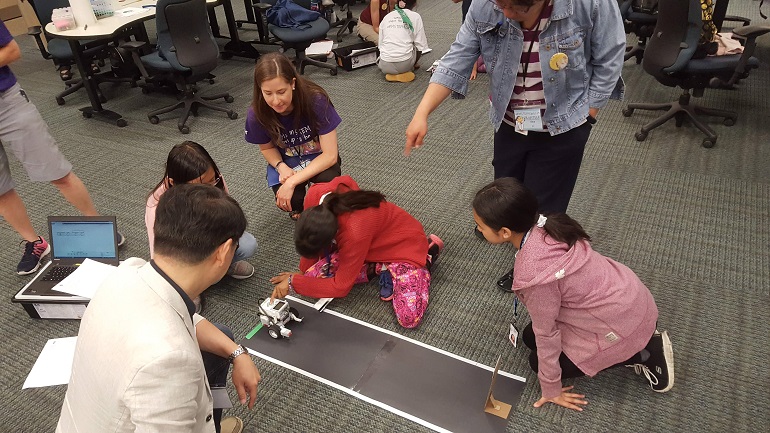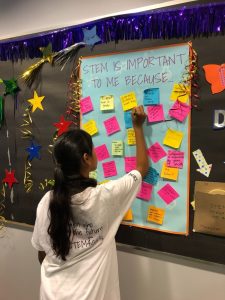With Canadian students now back to school, summer camp may already seem like a distant memory, but camps this summer – day, overnight and virtual camps – were a welcome relief for children and teens that had endured very limited access to fun extracurricular activities over that past 18 months.

Image from IBM STEM Camp 2019
IBM Canada, along with its ten partners, delivered its first national Science, Technology, Engineering, Arts, and Math (STEAM) virtual summer camp for students entering grades 7 – 12 this fall. Access was free and more than 3,000 teens participated from 9 provinces, which demonstrates a good appetite for STEM learning in Canada.

Jen Roynon, CSR Leader, IBM Canada
I asked Jen Roynon, CSR Leader, IBM Canada about its STEAM summer camp, and how this inaugural summer camp, as well as other its other STEM initiatives, help to drive interest in STEM as well as address gender disparity in STEM in Canada.
“40 interactive sessions were on offer [in our STEAM camp], including digital art, building chatbots, creative technical writing, cybersecurity, and hands-on science experiments,” shared Roynon.
“The camp also offered the participants a chance to build new friendships, learn from STEAM experts from across Canada, participate in daily competitions and win swag.”
Added Roynon, “We partnered with 10 corporations and communities, and engaged a team of 225 IBM volunteers to make this camp happen. It was well received by the both the students and their parents.”
Roynon commended IBM Canada’s partners, which included, “Cisco Canada who managed the technology and ensured seamless session [and] Alto Networks, RBC, TELUS, University of Calgary, ROBO Raiders, MLSE, SNP STEAM Academy and Fortinet …[which] created educative and interactive content for various sessions.”
A hybrid of interactive learning design and tech solutioning was employed to create student engagement and collaboration in this virtual offering.
Explained Roynon, “Through the efforts of Cisco Canada upgrading our Webex capabilities, other partners and IBM Volunteers who created sessions and facilitated discussions in large and small group settings, and the utilization of Slack, the camp fostered engagement and collaboration in a virtual environment.”
“Most sessions were not hosted in a webinar format,” added Roynon “which allowed participants to see each other and engage in the chat (as well as in the Slack channels!).”

Image from IBM STEM Camp 2019
“Each day camp leaders populated the Slack channels with “prompts” to get participants chatting and engaging. Additionally, the camp utilized technology to make sessions more personable and have more opportunities for active learning. For instance, in the Design Thinking session, session leaders used MURAL so that students could work together on the same document to problem solve.”
I asked Roynon about broader strategies IBM Canada is employing to engage Canadian youth in tech, particularly girls.
Roynon replied, “Even though gender disparity is more visible at the high school and undergraduate levels, middle school is a critical time to influence STEM career choices. IBM has a longstanding commitment to leading diversity and inclusion, with initiatives like STEM for Girls which “Inspires a future generation of girls to embrace STEM” and our P-TECH program (Pathways in Technology Early College High Schools), which is now in more than 240 schools in 28 countries, “Building confidence in STEM and Workplace learning skills.”
I also asked how IBM Canada can inspire students toward STEAM learning, and how it endeavours to make tech learning and career planning more diverse and inclusive.
“Gender parity requires an intentional strategy to normalize STEM in everyday life,” said Roynon. “This means creating an ecosystem view where corporates, teachers, parents, and industry experts collaborate to encourage girls to embrace STEM and provide enablement opportunities throughout their journey.”
“No doubt, gender inequality is a broad social problem that demands societal-level changes, but there is a lot that we can do to support progress,” stated Roynon. In particular, Roynon offered the following strategies:
- “Connected experiences – In business, our hiring practices should at least reflect the diversity of the pool of candidates we draw from, if not more [and] for IBM, that tends to be mostly college graduates.”
• “When hiring for technical and engineering roles, we should widen the aperture beyond science and engineering graduates. There are many examples of successful technologists who studied history or psychology in college.”
• “And if we really want to achieve societal-level change, we must work with children and encourage more girls in STEM subjects. IBM’s #SheCanSTEM campaign showcases the achievements of women to help young girls find STEM role models. IBM also participates in many community initiatives to encourage girls in STEM as well as teacher development and student mentorship programs.”
There is such a demand for creative problem solvers and technologists in Canada, and so I find it commendable that communities and corporations are bringing innovative STEAM opportunities to Canadian youth.
If you are leading STEM programs for Canadian young people, contact me.
More articles on STEM



